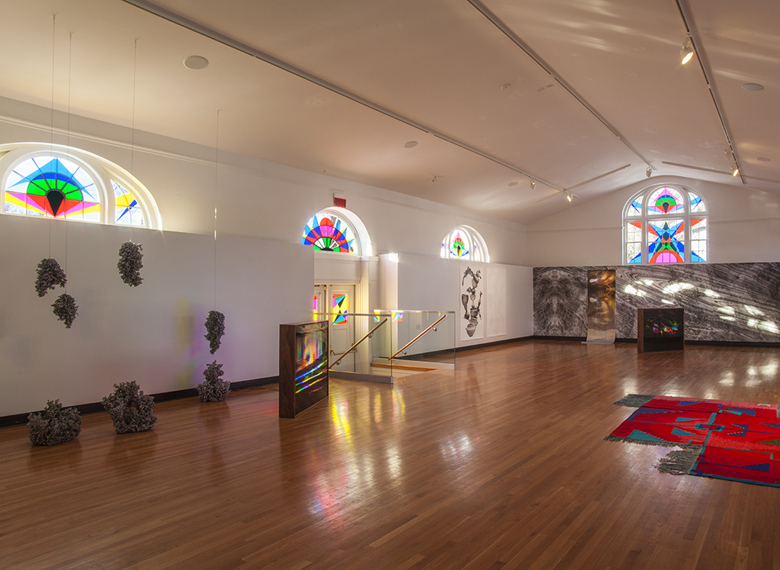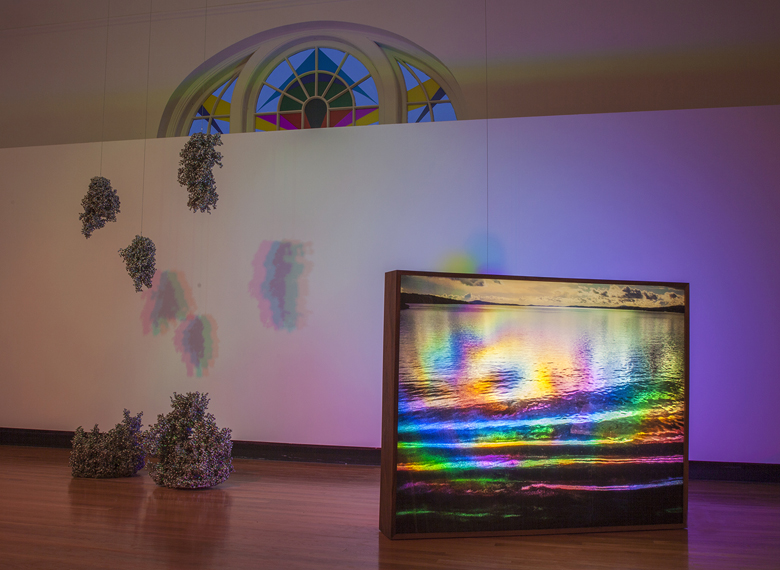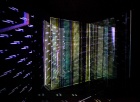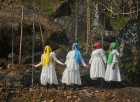I’ve seen this exhibition a few times already, but that doesn't mean I'm feeling comfortable. I am naked inside the Southern Alberta Art Gallery, taking part in a nude viewing of Another Name For Everywhere by Calgary artist Miruna Dragan.
I think back to a few months ago when the exhibition curator, Christina Cuthbertson, mentioned the Southern Alberta Art Gallery’s aspirations to host nude viewings of this work. I think back to how I figured it wouldn’t end up happening. But here I am: naked, with the artist on the other side of the door guarding my privacy. My emotions swing from trepidation, nervousness, and shame, to confusion, excitement, enchantment, peacefulness, and—by the end of my visit to the gallery—serenity.
Another Name For Everywhere, Dragan’s first solo exhibition in a Canadian public art gallery, is an immersive collection of technical experiments, complemented by nude viewings and three days of improvisational performances by her forest-witch-jazz trio, Carbo Carbonis. Working to activate and free all modes of sensation, the exhibition is woven with a buzzing undercurrent of magic. Lightboxes, rugs, photographic prints, encaustic painting, and sculptures positioned around the room stand not just as objects, but as perceptual portals through which I find myself transcending the physical space. You could call it a cathedral of the senses.
Coloured light blazes into the gallery, tinted by vinyl applied in geometric shapes to the surrounding half-moon windows up high—a work itself titled Eyes Breathing In, Eyes Breathing Out. Appearing like simple geometric stained glass, these windows bestow an abstract sense of divinity on the room—a space with a vaulted cathedral ceiling—and a sort of exaltation. Another Name For Everywhere echoes icons of the spiritual journey, using devotional affect as medium, like any pencil or brush.
You could call it a cathedral of the senses.
Half of the gallery is blanketed in wallpaper, patterned to duplicate the photographed texture of a salt mine in Romania, the country of Dragan’s birth.1 Two walnut-framed freestanding lightboxes titled When We Stand On The Threshold Between Two Worlds, Our Soul Is Engulfed In Dreams (I & II), are positioned on either end of the space at opposing angles. Photographs in the lightboxes are illuminated with RGB lights, combining to cast CMYK (cyan, magenta, yellow, and black) shadows. These shadows appear to be cast on a series of aluminum clusters both freestanding and suspended behind the lightbox to my right, but—looking up—I see three more RGB bulbs reinforcing the colours, mixing to create an even brighter CMYK.2
Titled In The Telestic Waters, I See…, these clusters are the large-scale results of Dragan’s experiments with molybdomancy, an ancient method of divination where hot metal is poured into a vat of water, suddenly cooling it into a particular shape that can be read as a fortune-telling omen. The clusters beg to be interpreted. Where the emerging image of an elephant would mean luck and good health, and a fish good news from abroad, I see stalactites and stalagmites. I see the inside of a cave: comfort and safety within this now-sacred space.
A 10-foot long photographic print on metallic paper, The Vale of Avernus, hangs on the wall behind the other lightbox to my left, tumbling down onto the floor. This piece continues the thematic exploration from a previous photo collage, Xilitla Forever, examining Las Pozas, a massive outdoor sculptural wonderland in the mountains of Xilitla, Mexico.3 An elaborate series of surrealist concrete structures created between 1949 and 1984 by poet and surrealist Edward James, Las Pozas was made with the understanding that art is a catalyst for finding the divine within physical space. Dragan continues this divine exploration in a new location through The Tale of Avernus, with a pathway of ascending/descending incisions, intricately hand-cut into the paper, weaving their way vertically over the metallic print. These cuts, made with the Japanese paper cutting technique of Kirigami, again suggest a threshold to be negotiated; shall I descend into oblivion, or ascend into enlightenment?
Appearing like simple geometric stained glass, these windows bestow an abstract sense of divinity on the room—a space with a vaulted cathedral ceiling—and a sort of exaltation.
Mobile in the room are a series of rugs woven by Jolie Bird titled Visitation I – VI. Based on Fibonacci’s mathematic sequence of integers, these geometrically patterned rugs can be moved, fitted together, laid on, and layered in whatever way I please. I arrange them on the floor under a similarly math-based work hung on the gallery’s tallest wall, a large-format work of dyed lambskins mounted on rice paper marked with an endless swirling vortex of logic symbols (⇔ ∃ ∨ ≔… ). Titled like a philosophical mathematic equation, it has been named ...Because There Exists Another Name For Everywhere It Is Possible Therefore It Is True When Either Or Both Are True… provoking me—as with all the works—to make my own meaning, calculate my own equations, discover myself by exploring the unknown.
This provocation to experiment and experience is exactly what makes the exhibition a success. Miruna Dragan has spent nearly two decades creating videos, photographs, installations, and experiences that investigate the limits of human understanding, prompting us to re-examine what might seem simple and ordinary, to feel things as if born anew. My nudity has challenged and liberated me to consider both the exhibition, and my existence, in new ways. I am enraptured, open to new possibilities, and compelled to deeper contemplation even after leaving this transformative space. We are porous entities, constantly navigating thresholds of (what)(and) ∃ (who)(then) ≔ (where)(or) :⇔ (when)(if) ∨ (how)(but) ⇒ why. I am clothed again, but no longer closed off.
Another Name for Everywhere was organized by the Southern Alberta Art Gallery, curated by Christina Cuthbertson, and exhibited December 3, 2016 - February 5, 2017.






